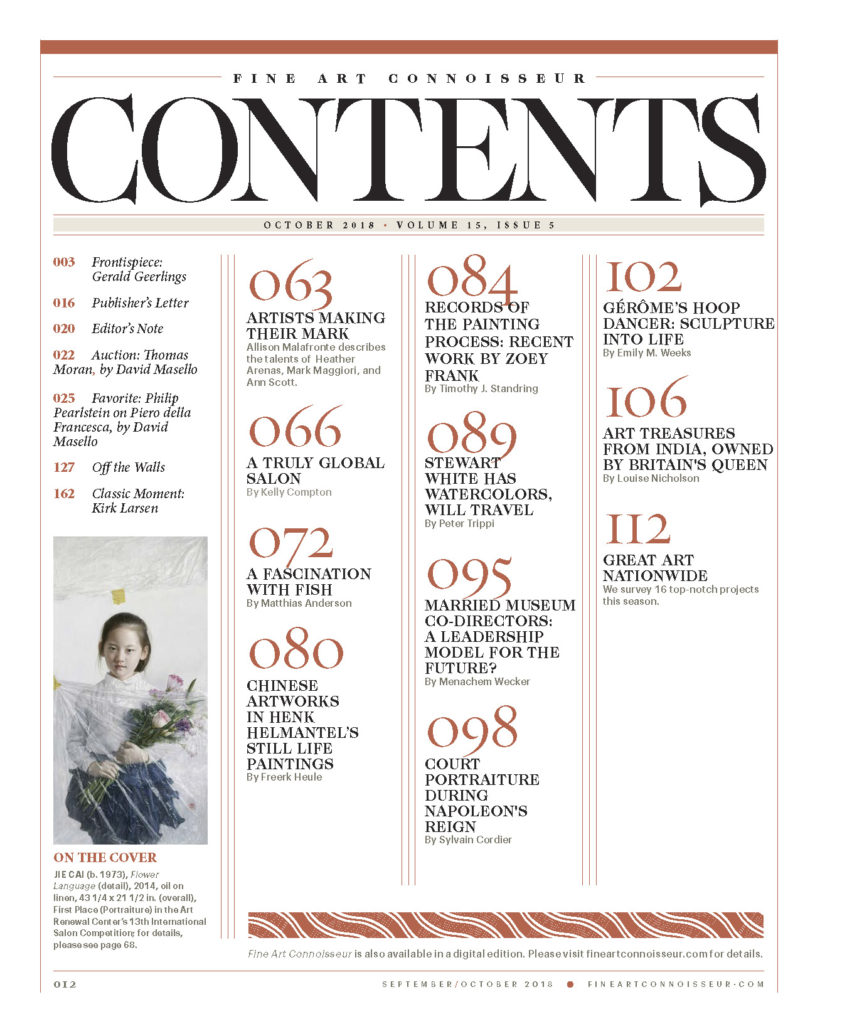Fine Art Connoisseur September/October 2018, Editor’s Note:
By Peter Trippi
For well over a decade, artists, curators, and collectors have debated whether the term “contemporary realism” makes sense generally, and specifically to folks who don’t know much about what we do. Though some say names don’t matter, I disagree — “branding” is everything in our society, so if people can quickly grasp who you are, things just work better.
When you browse Fine Art Connoisseur, you’ll see lots of representational artworks made recently. By “representational,” I mean representing something recognizable. It’s a mouthful of a word, and not exactly enticing, so generally we use “realist” or “realism” instead. Problem is, “realism” has encompassed so much over time that it’s hard to visualize what it is now — is it the peasant scenes made by Gustave Courbet in the mid-19th century, the gritty visions of city life painted by John Sloan or Edward Hopper, the slick surfaces of 1960s photorealism, the meticulous draftsmanship of 1990s classical realism? “Realism” is far from perfect, but it’s what we’ve got in our vocabulary for now.
More easily replaced, perhaps, is “contemporary.” How about “modern” instead? Purists say that “modernism” started in the late 19th century, reached its apogee during the mid-20th century, and lost its mojo in the 1980s. That may be true technically, but “modern” sure still has currency in the wide world. Every generation considers itself modern, and it’s no accident that Modern Family has been a hit TV series since 2009; it is literally too old to be modern anymore, but we know exactly why it retains that name.
In the art arena, “modern realism” has been uttered by quite a few experts over the years, referencing an array of artworks that we love here at Fine Art Connoisseur. The Smithsonian American Art Museum used it to describe the marvelous Sara Roby collection it exhibited in 2014. The thoughtful curators at London’s Tate galleries use the term regularly, as does the British-born, Michigan-based scholar Alex Potts. Not surprisingly, the American scholar John Wilmerding has used “modern realism” to describe the world of Edward Hopper and Andrew Wyeth, among other masters.
Does any of this matter? Possibly not, but I think it’s helpful to stir the pot every now and then, to remind everyone that the exciting art now being made across America (and indeed the world) will be better appreciated if “new-comers” know what to call it. Perhaps there’s something snappier about “modern realism” than “contemporary realism,” so please mull it over and let me know what you think.
Finally, I would like to welcome to Streamline Publishing Scott Jones, our new associate publisher and Western regional marketing manager. Scott recently joined our team after 10 successful years as general manager of Legacy Gallery in Scottsdale. Scott is an accomplished public speaker and art juror, and I am particularly looking forward to collaborating with him at the Figurative Art Convention & Expo (FACE) this coming November. Welcome aboard, Scott! Download the September/October 2018 issue here, or subscribe to Fine Art Connoisseur today so you never miss an issue.
Download the September/October 2018 issue here, or subscribe to Fine Art Connoisseur today so you never miss an issue.
Sign up to receive Fine Art Today, the free weekly e-newsletter from
Fine Art Connoisseur magazine.









Great timing.
I just had a discussion with my nephew last week. He is young, 35, a neurosurgeon, who wants to start collecting art. I gave him a painting for his home office to celebrate his new 2 million dollar home. Why am I’m saying this, because he can afford to buy art but his wife buys pieces made in China from Homegoods and Target. I asked if he liked the representational piece I gave him and he said “yes, but what does that mean?” Ugh….
Yes, we need a term! Modern Realism is a bit snappier than other terms, and for me, a bit of rebelliousness by borrowing a word – Modern- from a movement that at times has loathed the painting of recognizable things. My biggest problem with incorporating the word ‘modern’ is that is can become confusing as time passes. Modernism at this point, is a historical art movement – a thing of the past. I’ve heard of a few art museums that have changed their names, substituting the word ‘contemporary’ for ‘modern’ to try to avoid the confusion between what’s being done now and what fit’s into the genre of Modernism. As much as I think Modern Realism is a good fit now, in the future it may just add to already confusing terms. As for a better name, I’m afraid I don’t have one – but I’ll be spending some time thinking on it.
Definitely not “Modern” Realism. That only leads to confusion, since “Modernism” has a specific meaning, not only in the visual arts, but in culture in general (as some noted above). Unless one intended to suggest Realists who valued “modernist” (formalist) qualities over “post-modernist” issues. (I heard Bill Beckman say way back int he 1970s in a CAA panel, if we learned anything from Modernism it was that a painting has to be a good painting.) And what of “post-post-modern”….a mouthful, but it does bring forth the idea that these realists have not only gone beyond modernist abstraction, but also beyond post-modern concerns. Then there is “New Old Masters” (I believe from Donald Kuspit). (I even saw “post-contemporary” which seems odd.) Terms like “New Old Masters” and “Post-post-modern” may be a mouthful but the terms do carry meaning, especially when they have a history (such as the use of “modernism).
How about just “realism”. The question is a good one and something which deserves mulling over. I don’t know that we need to sub-classify realism, however. The “isms” always confuse collectors. Mine is a different battle – explaining tonalism. The style that chose me is one which doesn’t even pass spell check. Imagine if I had to explain post modern contemporary tonalism as my style! I’ve settled on saying tonalism emphasizes mood and atmosphere. The realists have it easy. Either way, the collector has an understood starting point whichever qualifiers are added to the name.
I think “Post-modern” puts it squarely as a movement that is after “Modernism” which I identify as art from around 1900 to around 1960 or slightly beyond, which as noted, does not include the current wave. Unfortunately, “New-Wave” has already been taken by another genre. “Post-modern” has worked for literature, but as far as I know, has not been applied to the plastic arts. “New Post-modern” or “Contemporary Post-modern” anybody?